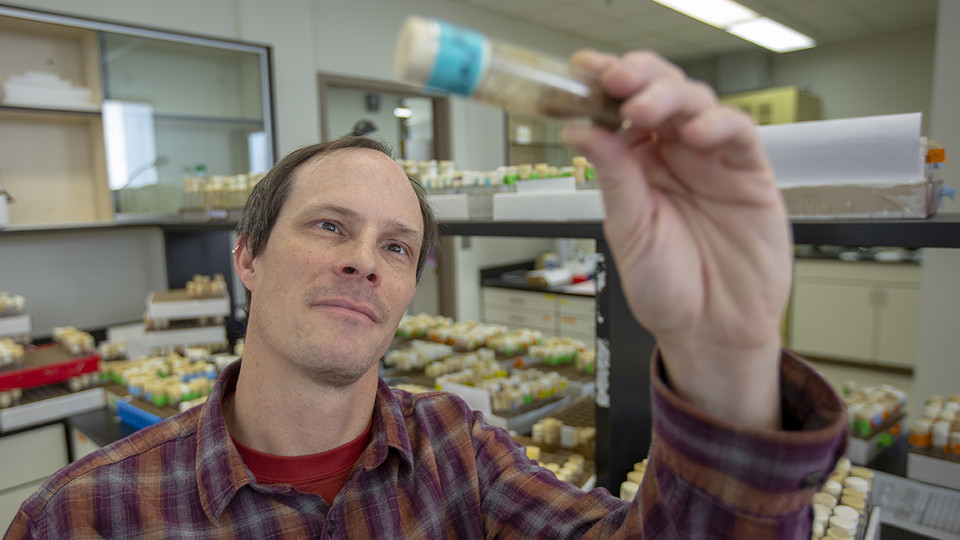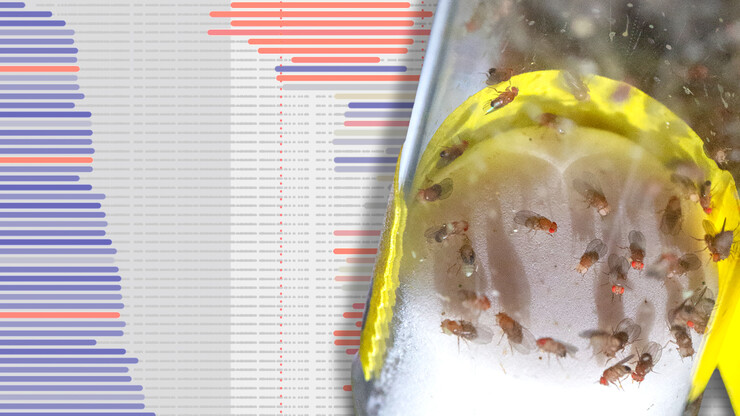· 5 min read
Study: Selfish genes can act as both makers, breakers of species

A selfish streak in genes known to drive species apart might occasionally bring them closer together, says a new study from the University of Nebraska-Lincoln and University of Rochester.
Though the vast majority of genes are essential to organisms’ survival and reproduction, some selfishly turn against their counterparts to improve their own odds of getting passed down through generations. The phenomenon also seems to promote the emergence and divergence of species by ensuring that interbreeding will sterilize one of the sexes – usually the male offspring.
But new evidence from two fruit fly species – one global, the other confined to a tiny island in the Indian Ocean – suggests that selfish genes may sometimes reverse this reproductive repercussion.
Some organisms carry two variations, or alleles, of the same gene. When cells divide to form sperm or eggs during meiosis, those two alleles randomly disperse and end up in roughly equal proportions of offspring. Yet selfish alleles can cheat this law to infiltrate more than 50 percent – a hereditary gambit known as meiotic drive.
That’s good for the alleles but bad for the species. Selfish alleles often reside on the X chromosome, one of two DNA bundles that determine an organism’s sex. Because male cells typically have an X and Y chromosome, their sperm contains one or the other. To gain an advantage, selfish X-linked alleles kill sperm carrying their counterparts on the Y chromosome, which codes for males. That means selfish alleles can dangerously skew a species’ male-female ratio.
Fortunately for species, Y chromosomes can develop a resistance to these attacks. The X-linked alleles then overcome this resistance, which triggers another counter from the sperm, leading to an open-ended genetic arms race. For reasons that remain unclear, this arms race also seems to disrupt sperm production when two species interbreed.
Nebraska’s Colin Meiklejohn and colleagues did identity multiple regions of the X chromosome that cause sterility in the fruit fly hybrids, consistent with the conventional view of meiotic drive and species formation. So when the researchers transferred a certain selfish allele-bearing chunk of the X chromosome from one fruit fly species to the other, they expected that it – like multiple others – would turn the male offspring infertile. Instead, those males retained the ability to reproduce.
That wasn’t all: After comparing the genetic makeup of both species, the team found that the two actually share that same selfish allele on their X chromosomes.
“What this suggests is that, sometime in the past, there was a hybridization event,” said Meiklejohn, assistant professor of biological sciences at Nebraska. “And (the gene) jumped in, like, yesterday, in terms of evolutionary time. It was super-recent. So that was a surprise. We didn’t know that this thing had … moved between species.”
By reducing the differences between the two species’ X chromosomes, this proliferation of the selfish allele may have aided rather than impeded the ability to interbreed, Meiklejohn said.
“So in this sense, the (allele) – instead of causing sterility, instead of promoting or reinforcing speciation – it may have undone that,” he said. “It may have actually erased any hybrid sterility factors that were there. This one was basically the opposite of a sterility factor.”
The finding also suggests that interbreeding opportunities, or lack thereof, could ultimately define the role that selfish alleles adopt, Meiklejohn said. When those opportunities arise, selfish alleles may begin to erode the genetic barriers that separate species. In this case, the globe-trotting Drosophila simulans species likely reached the Madagascar-adjacent island of Mauritius and bred with Drosophila mauritiana, spreading this X-chromosome region throughout the island species.
But without that hybridization event, the selfish allele might have instead fortified the species barrier.
“If these two species were completely on opposite sides of the world and never saw each other,” he said, “this couldn’t have happened.”
Better grasping these circumstantial side effects of selfish genes could help biologists better trace the evolutionary histories of species, Meiklejohn said. Eventually, that understanding might even inform ongoing efforts to control pests by quickly propagating certain genes through an entire population.
“You can imagine popping into a mosquito a (selfish) gene that makes those mosquitoes unable to carry malaria or unable to transmit dengue fever,” he said. “A big challenge with this that people are just starting to think about and observe is the idea that populations could be resistant. It could work great in the lab, but if it confers any kind of detriment to the insect that carries it, you’re going to very quickly have resistance pop up in populations.
“That sounds a lot like (meiotic) drivers and resistant Y chromosomes. And so, in general, studying the dynamics of selfish genes could potentially help with designing or making gene-drive systems useful.”
The team reported its findings in the journal eLife. Meiklejohn authored the study with the University of Nebraska-Lincoln’s Kathleen Gordon; the University of Rochester’s Daven Presgraves, Thomas Rzatkiewicz, Christina Muirhead, Emily Landeen, Sarah Kingan, Anthony Geneva, Jeffrey Vedanayagam and Daniel Garrigan; and David Stern of the Howard Hughes Medical Institute.








